Adam Yamey's Blog: YAMEY, page 106
November 25, 2022
Our local library saved from closure
THE NOTTING HILL GATE public library is close to where we live. It consists of three main rooms. Two of them have beautiful painted stucco ceilings. The third, which might have once had such a ceiling, does not have one now. However, it retains some wood panelling with an upper carved wooden margin. Each of the rooms retains the remnants of fine stucco work on their walls. The library occupies much of the ground floor of a large house at the corner where Pembridge Square meets Pembridge Road.
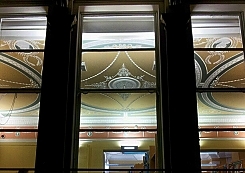
I asked one of the librarians about the history of the building housing the library. She believed that it had once been a large private residence, which the last owner had given the local authority many years ago. She told me that in addition to the library, the house has fats on its upper floors. Sadly, the ceilings have to be restored often because there are often water leaks from the upper floors.
A few years ago, there was a real risk that this branch library would be closed by the local Council (The Royal Borough of Kensington and Chelsea). Vigorous protests by the branch library’s many users and other locals saved the place from closure. To reduce running costs, the library is not always open, but access is possible at odd times almost every day of the week except Sunday.
November 24, 2022
A movie worth missing
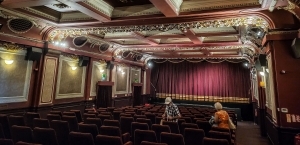 Gate cinema, Notting Hill Gate, London
Gate cinema, Notting Hill Gate, LondonIt’s called “The Menu”
It’s an awful tasteless film
Give it a wide miss
November 23, 2022
Dr Who and me
CHICAGO WAS MY HOME for the last few months of 1963. My father was a visiting professor at the University of Chicago during that period. While we were in Chicago, President John F Kennedy was assassinated. However, that was not the only momentous event that I recall from that time,
My best friend in London, whom I had known for about seven years, Nicholas Gilks who is no longer alive, sent me an airletter in which he wrote that he could not wait for me to come back to London, not because he was just missing me, but because he wanted me to watch the new, exciting television programme that had begun whilst I was away. The programme, which still runs today in 2022, was “Dr Who”. It was first broadcast on the 23rd of November, the day after Kennedy was shot.
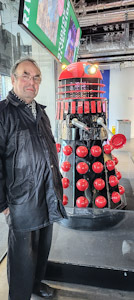
Well, “Dr Who” was certainly a fine programme. I used to watch it at the Gilks’s home because we did not have television at our family home, and never ever did. To reach my friend’s home, I walked. On the way, I used an unlit pathway that runs between Hampstead Way and Temple Fortune Lane, where Nicholas lived. Frankly, the ominous Daleks that starred in the programmes every week terrified me so much so that I was afraid of walking home along that pathway in the dark. So, Dr Gilks, my friend’s father, used to accompany me to that dark passageway and waited till I reached the far end of it. For this, I was very grateful.
Today, a sunny Sunday morning, the 20th of November 2022 (almost 59 years after Kennedy’s death), we walked along the Hammersmith riverside and reached the Riverside Studios, where we stopped for a coffee in its superb new café. Standing next to the doorway and pointing its weapons at the tables in the café stands a real-life Dalek. Why is it there you might ask. The answer is that between 1964 and 1968, “Dr Who” was filmed in the Riverside Studios, which was then a BBC studio complex. Furthermore, and worryingly, it was from the water beneath the nearby Hammersmith Bridge that the Daleks commenced their attempt to invade the Earth.
Luckily, the sun was shining brightly and there were plenty of people out and about. So, there was little chance that my childhood fears about the robotic Daleks would be awakened.
November 22, 2022
A quirky little open space in North Kensington
OVERLOOKED BY GOLDFINGER’S brutalist block of flats and hemmed in by Elkstone Road, Golborne Road, and the tracks of the Great Western Railway, there is a small patch of ground that serves as a little haven. Usually occupied by a few local characters, this space measures about 40 by 13 yards. It is The Elkstone Road Garden Oasis.
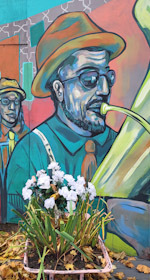
A curved wall at its northern end is covered with well painted murals depicting musicians and other figures, who I guess might be portraits of people well-known to those who use the garden. There are plenty of plants in this little oasis. Some of them are plastic artificial flowers picturesquely positioned. Others are real. Some of them have little notices next to them, identifying and explaining something about them. There are also printed notices that contain worthy thoughts about life. Amongst the rather tatty chairs, tables, and a small bookshelf, there is a wooden bench with a label stating that it was donated to a parochial organisation by the Chelsea Physic Garden. An online article published in 2018 (https://communityreporter.net/story/oasis-north-kensington-4-jun-2018-1249) revealed:
“The Elkstone Road Garden Oasis in fact, a small strip of land with a history of being neglected and abused. Originally rescued by the work of MIND volunteers the Oasis is now being managed by the Chelsea Physic Garden, which enjoys a somewhat longer history being created in 1683. Building on the work completed by MIND the Physic Garden, with grants from the Royal Borough of Kensington and Chelsea, Band Trust, City Bridge Trust and Turning Point, seeks to provide the local community with a beautiful space, in which the people who live in this area, adults and children, can enjoy being involved in the world of plants and wildlife. Colville Primary school are already participating in developing the garden, with visits every Thursday by Year three pupils. This is a popular activity and always provides a healthy injection of enthusiasm into the Garden.”
Long before Trellick Tower was constructed in the early 1970s and when Elkstone Road was named ‘Southam Street’, the area now occupied by the open space and that where Trellick Tower now stands was covered with rows of small, terraced houses. Unlike the nearby Meanwhile Garden (running alongside the Grand Union Canal), which is well-documented, the small, rather quirky open space I have described above seems to be slightly ‘off the radar’.
November 21, 2022
An artist and teacher in West Hampstead
WHILE I WAS STUDYING to become a dentist (in the late 1970s), I used to attend an etching and engraving class in a studio in West Hampstead’s Sumatra Road. The class was supervised by the owner of the studio, my mother’s cousin Dolf Rieser (1898-1983). Like my mother, he was born in South Africa. They were both born in King Williams Town, but he was 23 years older than her.
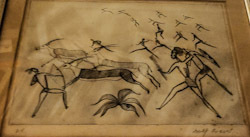 An engraving by Dolf Rieser
An engraving by Dolf Rieser Dolf ‘s childhood memories evoke South Africa as it was at the turn of the century (19th/20th) and are recorded in his unfinished autobiography (dolfrieser.com). Here is an extract that gives a flavour of them:
“The climate of King William’s Town was particularly difficult to bear and my mother suffered greatly especially where her nerves were concerned. I vividly remember her awful attacks of migraine when she had to stay in a darkened room. In the end we decided to leave South Africa, as I shall relate later on . My uncle, my mother’s brother, was at that time living on the border of Basutoland. He was running a small trading post and also kept some horses and sheep. This place was right up on the high plateau and was called Moshes-Ford after the famous Basuto chief, Moshes. My uncle invited us up to him for a holiday and I think we first took a train and then had to continue by horse and carriage, which presumably was also the postal service at the time. I remember well an “ooutspan” for lunch near an immense field full of dried bones and skeletons. These were the remains of the “Rinderpest” which shortly before had nearly wiped out the cattle of South Africa. I played football with a cow or ox skull, very much to the annoyance of the grown-ups. The following night we had to spend at the German Pastor’s home and I remember how impressed I was with the enormous bed and unknown eiderdowns.”
The ’Rinderpest’ was a disease that afflicted cattle.
During his classes at Sumatra Road, he would regale us with stories of Paris in the 1920’s and 1930s, when he was there learning etching an engraving in the studios of both Stanley Hayter and Joseph Hecht. One story that sticks in my mind is how he used to attend the same Parisian café as Pablo Picasso. The great master sat at one table alongside the the other leading artists in Paris, and junior artists like Dolf sat close by at another table.
Dolf was an excellent teacher. He showed us how to etch and engrave. However, what impressed me most is that he had the ability to look at his students’ works in progress, understand what we were trying to achieve, and then provide constructive (rather than prescriptive) advice.
I really miss Dolf, even though it is so many years since he died. He had a wonderful sense of humour, was a wonderful raconteur, and, having once trained as a biologist (before becoming an artist), a wonderfully adventurous approach to his métier.
November 20, 2022
A trade union for actors and actresses
WHILE DRINKING IN the first-floor bar of the Duke of York’s Theatre (‘DOY’) in London’s St Martin’s Lane, I noticed an interesting small commemoration plaque. But before discussing that, first a few words about the theatre.
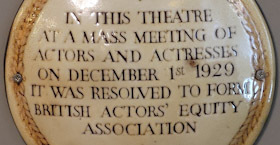
The DOY was opened in 1892 with the name ‘The Trafalgar Square Theatre’. Later, it was given its present name in honour of the Duke of York, who later became King George V. It was designed by the leading theatre and music hall architect Walter Emden (1847-1913). Amongst the many plays performed in this beautiful fin-de-siecle theatre where JM Barrie’s play, the precursor of his book, “Peter Pan, or The Boy Who Wouldn’t Grow Up” which was premiered in late 1904. The theatre was bought by the Ambassador Theatre Group (ATG) in 1992. Since its opening, many successful plays have been performed in it. The play we watched in mid-November 2022 was “The Doctor” by Robert Icke. It was a lively and engaging play that was crammed a bit too full of dilemmas that trouble us today.
The plaque, which I noticed whilst waiting to enter the auditorium was put on the wall of the bar to celebrate that on the 1st of December 1929, a mass meeting of actors and actresses was held in the theatre. Those assembled resolved to form the ‘British Actors Equity Association’. Above this plaque, there is a framed document with many signatures below the words:
“We the undersigned, hereby pledge ourselves that we will not enter into any engagements with Theatre Managers on conditions which would deny our right to refuse to work with non-members of Equity.”
Amongst the signatures on this undated document, I was able to read those of Flora Robson, Hermine Baddeley, Violet and Irene Vanburgh, Marie Burke, Reginald Backs, Robert Donat, Sybil Thorndyke, Leslie Henson, Godfrey Searle, and many others.
This document marked the birth of the actors’ union known as Equity. As the document suggested, and like many other British trade unions, Equity adopted the closed-shop policy. When this was made illegal by Margaret Thatcher’s government in the 1980s, joining the union required evidence of having experience of a sufficient amount of paid professional work.
I must admit that I am not sure whether seeing the memorial to the foundation of Equity was not more exciting for me than watching the play I had come to see.
November 19, 2022
A thatched church and Alfred Lord Tennyson
THE POET ALFRED TENNYSON made his home in the village of Freshwater Bay on the Isle of Wight (‘IOW’) from 1853 until his death. His presence there attracted many Victorian cultural figures to the village either as residents or as his visitors. In 1907, fifteen years after Tennyson died, the Bishop of Winchester visited Freshwater and decided that the village needed a better church than the rather primitive one being used at the time. The Reverend AJ Robertson, who was Rector of Freshwater in 1907, made a watercolour painting of the type of church he hoped would be built. It included a thatched roof. Such a church as he had envisaged was designed by the architect Isaac Jones of Herne Hill in London, and constructed on land donated by Tennyson’s eldest son Hallam, Lord Tennyson (1852-1928). It was Hallam’s wife Lady Emily (1853-1931; née Prinsep), who gifted the new church’s porch and suggested that the church be dedicated to St Agnes.
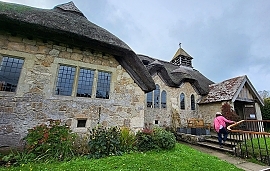
St Agnes is the only church on the IOW to have a thatched roof. Much of the building was built using stones from what had once been the home of the scientist Robert Hooke (1635-1703). The use of old stones makes some people believe that the church is older than it really is. One of the old stones has the date 1694 inscribed on it, a reminder of the origin of the stonework. The interior of the building is well lit by natural light through its many windows. The timber framed ceiling is fine as is the beautifully carved chancel screen. The screen with delicate bas-relief carvings of plants was created by the Reverend Thomas Gardner Devitt, who was curate of St Agnes between 1942 and 1946.
In brief, this thatched church is charming. In appearance, it manages to combine a feeling of mediaeval antiquity with the aesthetics of the Arts and Crafts Movement, which was in its heyday when St Agnes was built. Seeing it was one of many delightful experiences we enjoyed whilst spending a week on the IOW.
November 18, 2022
Day by day

Ev-er-y day
Surely succeeds yet another
Tomorrow follows
November 17, 2022
A house on the Isle of Wight and a plantation in Sri Lanka: chapter 2
THE PHOTOGRAPHER Julia Margaret Cameron (1815-1879; ‘JMC’) was born in the Garden Reach district of Calcutta (now Kolkata in West Bengal). Her father, James Pattle, was a prosperous English official in the East India Company. JMC and her six sisters, the surviving children of James and Adeline Marie Pattle, had a Bengali ancestor, Thérèse Josephe Blin de Grincourt (1768-1866) She was JMC’s maternal grandmother, a Bengali woman who had married a French man, Ambroise Pierre Antoine de l’Étang (1757-1866, whose presence in Bengal was recorded in “The India Office List 1825” as “De l’Étang, Chevalier Antoine, Knt. St Louis, assist. Stud at Poosa, 1796” (Poosa is in what is now Madhya Pradesh). They married in 1788. At that time, it was not uncommon for European men to have lasting relationships with Indian women. This is well-described in William Dalrymple’s book “White Mughals”. Later, in the 19th century, such interracial liaisons were heavily frowned upon. It was expected that ‘white’ men would only marry ‘white’ women. Incidentally, Thérèse was daughter of a French colonist and his Bengali wife.
As with her sisters, JMC was sent to France to be educated. She remained there from 1818 to 1834, when she returned to India.
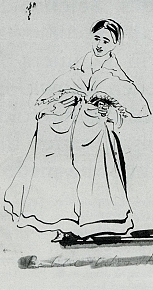 Julia Margaret Cameron by James Prinsep
Julia Margaret Cameron by James PrinsepIn 1835, suffering from ill-health, JMC travelled to the Cape of Good Hope. This part of what is now South Africa was favoured as a place to convalesce by Europeans based in India. It was in the Cape that JMC met not only the famous astronomer and an inventor of photography Sir John Herschel (1792-1871), but also the man whom JMC would marry in 1838: Charles Hay Cameron (1795-1880). Charles was in the Cape recovering from a malarial illness. A disciple of the philosopher Jeremy Bentham, he was a reformer of law in India and education, who also invested in coffee plantations (in 1848) in Sri Lanka.
Julia and Charles married in Calcutta, where she became a prominent hostess in the city’s British Indian society. During the 1840s, she corresponded regularly with John Herschel about developments in the science and technology of photography. He sent her two dozen calotypes and daguerreotypes, which were the first photographs he had ever set eyes on. The Camerons raised eleven children: five of their own; five orphans (children of relatives); and an Irish girl named Mary Ryan (whom they found begging on Putney Heath).
The entire Cameron family relocated to England in 1845, possibly because their two older children had settled there, and Charles had retired. They settled in Royal Tunbridge Wells in Kent. They became friendly with one of their neighbours, the poet Henry Taylor (1800-1886), who had worked in the Colonial Office under Robert William Hay (1786-1861), who might well have been related to Charles Hay Cameron’s mother. Later, the Camerons moved to East Sheen, which is closer to London than Tunbridge Wells.
It was through Henry Taylor and Julia’s sister Sara (1816-1887), who was married to Henry Thoby Prinsep (1793-1878), an official in the Indian Civil Service, that JMC was introduced to a set of noteworthy Victorian cultural figures. Henry and Sara had returned to England from India in 1835, and were living in (the now demolished) Little Holland House next to the house of the artist Lord Leighton, near Holland Park in west London. Their home became a meeting place for famous artists, as will be described later. It was here that Sara held a salon for pre-Raphaelite artists, poets, and aristocrats with an interest in artistic activities. At Sara’s home, JMC encountered, amongst other worthy cultural figures, the poet Alfred Tennyson (1809-1892).
Tennyson rented Farringford House in Freshwater Bay on the Isle of Wight (‘IOW’) in 1853, and purchased it three years later. In 1860, after a long visit to Tennyson on the IOW, the Camerons bought a property next door to Tennyson’s and named it Dimbola after one of their (then coffee) plantations in Sri Lanka. TO BE CONTINUED
November 16, 2022
Celebrities and criminals in Hampstead
THE ACTOR AND STAGE impresario Gerald Du Maurier (1873-1934) lived in Cannon Hall (14 Cannon Place in Hampstead) from 1916 until his death. His children, who lived there, included the novelist Daphne Du Maurier (1907-1989). The house was built in about 1720 and altered in the 19th and 20th centuries. Despite these changes, it remains an elegant residence in the heart of Hampstead.
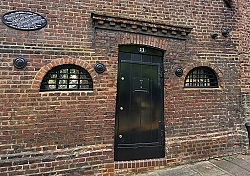 The former lock-up
The former lock-upSteeply sloping, narrow Cannon Lane runs alongside the eastern wall of the grounds of Cannon Hall. About halfway down it (between Squires Mount and Well Road), there is a doorway in the wall. There is one semi-circular window on each side of it. Each of the windows is behind a lattice of metal bars. A plaque nearby informs the viewer that this was once a parish lock-up in which prisoners were held temporarily in a dark cell. The lock-up was established in about 1730. In that era, magistrates held court proceedings in Cannon Hall. In 1829, when a police force was set up in Hampstead, court business and prisoners were held in the Watch House on Holly Walk.
At the bottom of the grounds of Cannon Hall, stands Cannon Cottage, which faces Well Road. This was constructed in the early 18th century. Between 1932 and 1934, Gerald du Maurier’s daughter Daphne lived in this substantial residence with her husband Frederick Browning, whom she had just married.
Further west along Well Road, there is what looks like a small factory with skylights. This was built as artists’ studios in the late 19th century. Known as Well Mount Studios, the artist Mark Gertler (1891-1939) moved into number 1 in 1915, and worked there. I am uncertain how long he remained at this address, but I know he had moved from it before he committed suicide.
The places described above can be seen by walking only about 335 yards. This is typical of Hampstead Village (or Town, according to some), which is literally packed with interesting sites, both historical and contemporary. If you wish to discover much more about this fascinating part of north London, you can buy a copy of my informative book “Beneath a Wide Sky: Hampstead and its Environs” (from https://www.amazon.co.uk/dp/B09R2WRK92).



